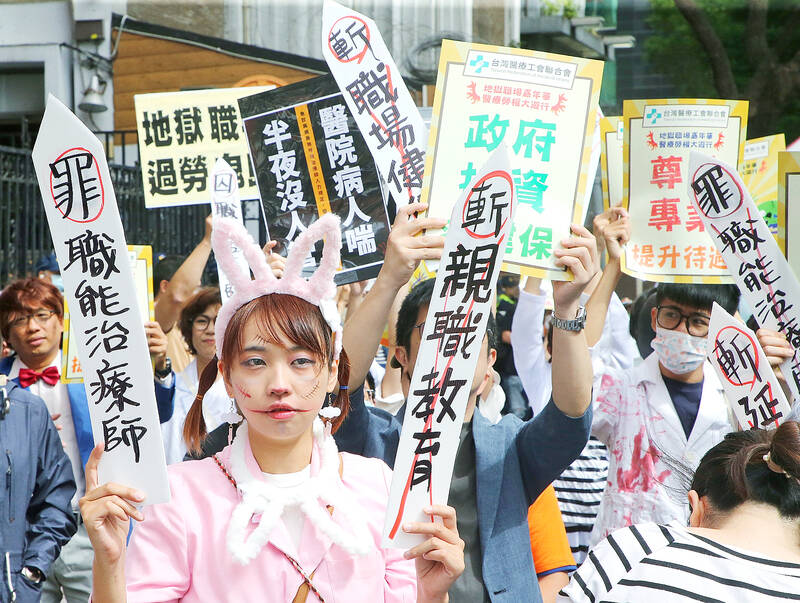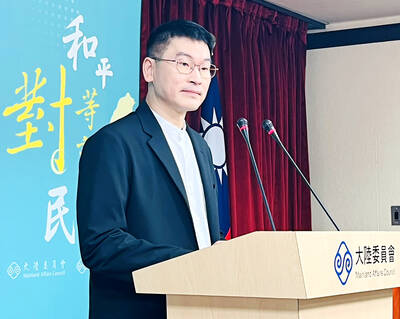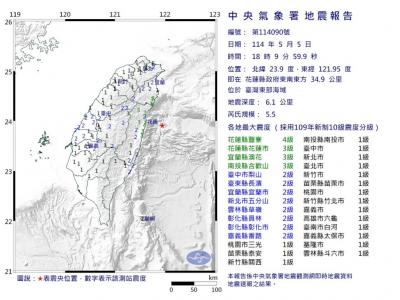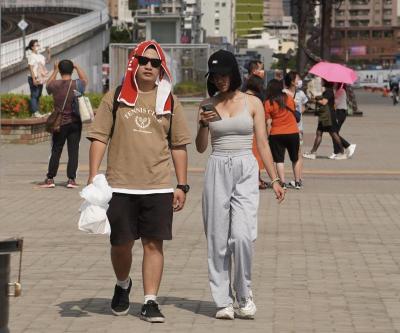The Taiwan Federation of Medical Unions (TFMU) yesterday held a rally in front of the Legislative Yuan and a short parade, urging the government to improve healthcare workers’ labor conditions by accepting its four main demands.
At about 1pm yesterday, a few hundred people, including some dressed in Halloween costumes, started gathering in front of a mobile stage set up in front of the Legislative Yuan in Taipei.
With slogans such as “Labor shortage makes us overworked ghosts,” “Working two or three types of shifts in a week turns us into zombies” and “Forced to do illegal practices makes us feel like phantoms,” the TFMU said that since Halloween is around the corner, it invited participants to dress up when attending the rally.

Photo: CNA
Several healthcare workers were seen wearing white coats with red paint spattered all over, to symbolize the “blood, sweat and tears” of healthcare workers who have to work in poor labor conditions and that the healthcare working environment is “hell.”
TFMU head Chao Lin-yu (趙麟宇) said the rally’s four demands for the government are to “replenish healthcare manpower,” “improve healthcare workers’ safety at work,” “allocate more of the National Health Insurance (NHI) budget to save the NHI system,” and to “let healthcare professionals receive the respect they deserve.”
Nurse representative Lo Yun-sheng (羅運生) said many nurses have left the workforce because they were overworked, as hospitals asked them to work 12 hours a day or to work two or three types of shifts in a week.
Nurses want a three-shift system to become law within two years to prevent nurses from being overworked, she said.
The TFMU said as there are also cases of physicians suddenly being asked to leave, that physicians’ labor rights should be protected by the Labor Standards Act (勞動基準法).
As some healthcare professionals are not allowed to perform certain practices, such as occupational therapists not being allowed to conduct “health promotion” without a physician’s prescription, legal amendments should be made to show respect for healthcare professionals, as well as salary increases, the TMFU said.
Separately, on the eve of the rally and parade on Saturday, the Ministry of Health and Welfare held a news conference that evening to explain the consensus it had reached in a meeting with 21 healthcare workers’ trade associations that afternoon.
Minister of Health and Welfare Hsueh Jui-yuan (薛瑞元) said 29 representatives from the associations, including physicians, nurses and pharmacists, attended the 2.5 hour meeting, and the ministry listened to their difficulties and suggestions.
On the issue of staff shortage, he said that some relatively newer licensed professions, such as dental technicians, optometrists and audiologists that cannot meet increasing demand, so comprehensive reviews would be conducted to make the worker-patient ratio and working conditions more reasonable.
Responding to the claim that Taiwan’s national health expenditure (NHE) is only about 6 percent of the nation’s GDP, lower than several countries, Hsueh said that Organisation for Economic Co-operation and Development countries include long-term care expenditure in their NHE, but it was not added to Taiwan’s NHE as of last year, so the gap is not that great.
The ministry also promised to periodically invite the associations to discuss better responding to their needs, he added.
Deputy Minister Victor Wang (王必勝) said the ministry hopes to hold at least two to three meetings per year, and that Saturday’s meeting was with medical associations, but since the rally was held by labor unions, the ministry is still negotiating with them when to meet to discuss issues this coming week.

An essay competition jointly organized by a local writing society and a publisher affiliated with the Chinese Communist Party (CCP) might have contravened the Act Governing Relations Between the People of the Taiwan Area and the Mainland Area (臺灣地區與大陸地區人民關係條例), the Mainland Affairs Council (MAC) said on Thursday. “In this case, the partner organization is clearly an agency under the CCP’s Fujian Provincial Committee,” MAC Deputy Minister and spokesperson Liang Wen-chieh (梁文傑) said at a news briefing in Taipei. “It also involves bringing Taiwanese students to China with all-expenses-paid arrangements to attend award ceremonies and camps,” Liang said. Those two “characteristics” are typically sufficient

A magnitude 5.9 earthquake that struck about 33km off the coast of Hualien City was the "main shock" in a series of quakes in the area, with aftershocks expected over the next three days, the Central Weather Administration (CWA) said yesterday. Prior to the magnitude 5.9 quake shaking most of Taiwan at 6:53pm yesterday, six other earthquakes stronger than a magnitude of 4, starting with a magnitude 5.5 quake at 6:09pm, occurred in the area. CWA Seismological Center Director Wu Chien-fu (吳健富) confirmed that the quakes were all part of the same series and that the magnitude 5.5 temblor was

The brilliant blue waters, thick foliage and bucolic atmosphere on this seemingly idyllic archipelago deep in the Pacific Ocean belie the key role it now plays in a titanic geopolitical struggle. Palau is again on the front line as China, and the US and its allies prepare their forces in an intensifying contest for control over the Asia-Pacific region. The democratic nation of just 17,000 people hosts US-controlled airstrips and soon-to-be-completed radar installations that the US military describes as “critical” to monitoring vast swathes of water and airspace. It is also a key piece of the second island chain, a string of

The Central Weather Administration has issued a heat alert for southeastern Taiwan, warning of temperatures as high as 36°C today, while alerting some coastal areas of strong winds later in the day. Kaohsiung’s Neimen District (內門) and Pingtung County’s Neipu Township (內埔) are under an orange heat alert, which warns of temperatures as high as 36°C for three consecutive days, the CWA said, citing southwest winds. The heat would also extend to Tainan’s Nansi (楠西) and Yujing (玉井) districts, as well as Pingtung’s Gaoshu (高樹), Yanpu (鹽埔) and Majia (瑪家) townships, it said, forecasting highs of up to 36°C in those areas